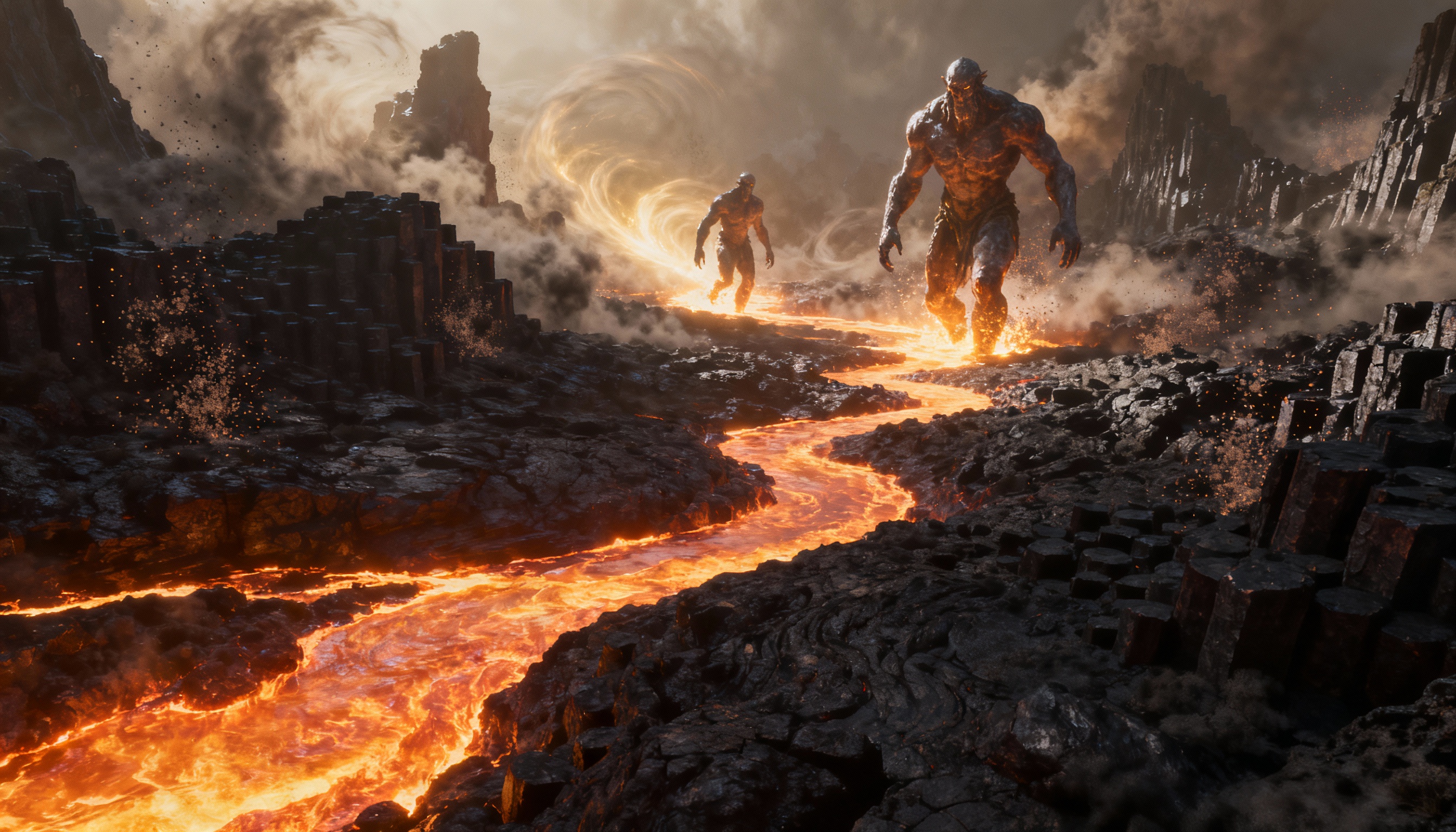The Weeping Forge

It began not with battle, but with sound — the sound of iron cooling under tears. The records of the Brovanthian chroniclers name this event The Weeping Forge, the first and last time that the earth itself was heard to mourn. In those days, the world was young and pliant, its bones still soft from the shaping hands of Moab and Baom. The mountains had yet to decide their height, and the seas knew no patience. The First Wardens walked the land then — creatures of thought and sinew, neither divine nor beast, tasked to tend the breath of creation.
Their unity was their flaw. When all things speak the same tongue, there can be no listening. The Wardens, crafted from the blended essence of day and life, grew curious about what lay between them. They sought to touch the silence that lingered where Moab’s breath met Baom’s dusk. That silence was Shadwe — not a being, but the quiet between pulses, the interval that gives rhythm to the cosmos. In their ambition, the Wardens mistook it for emptiness and sought to fill it.
The Splintering
The First Splintering occurred when the Wardens attempted to forge matter within that space of balance. They believed they could sustain the act of creation without need for pause. For seven days they labored at the Forge of Echoes, a place where Moab’s rivers met Baom’s winds. On the seventh day, they struck iron with flame drawn from both principles. The sound that followed was not thunder, nor song — it was the world gasping for balance. The forge cracked, and from its fracture bled the first shadow into matter.
This was not darkness in the sense of night; it was distortion — the breaking of rhythm. The molten iron hardened too swiftly, twisting into living shapes that knew neither rest nor purpose. They were the first aberrations, the ancestors of beasts that the Bestiary now classifies as shadowborn. When the Wardens beheld what they had made, they wept, for the creatures cried without breath and moved without soul.
The Division of the Wardens
Moab’s followers, the keepers of breath, sought to heal the land by softening the fire. Baom’s disciples, drawn by the beauty of light and order, sought to cage the new darkness with radiance. Thus the First Wardens were divided into four legacies: the Alfra who withdrew into the forests to preserve balance; the Duk who took to the stone to remember form; the Alferi who bound motion to purpose; and the Ida, who chose to wander — to learn the meaning of error. These four would inherit the world, though the price was memory of unity lost.
In Brovanthe’s oldest tablets, a passage remains: “They broke the silence to name it, and the name became longing.” It is said that even now, the forges of the Duk echo faintly with that first sound — metal weeping when struck too hot, as if recalling the sorrow that made it.
The Role of Shadwe
Later theologians misunderstood the event, claiming that Shadwe had risen against creation. But the true records make no such claim. The interval was never an enemy; it was the measure that kept day and night apart. When the Wardens forced creation without allowing rest, they unbalanced the cadence. Shadwe, the silence between, merely resumed its nature. It did not attack — it corrected.
This realization reshaped later philosophy. The Dhukura teach that every failure of civilization begins when motion forgets its stillness. The Moabite Scriptorium calls it the Law of the Pause: to act without interval is to undo the act itself. The Weeping Forge stands as the first testimony to this truth. Every hammer-strike since carries the memory of that divine hesitation.
The Aftermath and the Covenant of Reforging
After the Splintering, the Wardens gathered upon the plains where the forge had fallen. The land smoked, rivers boiled, and the air shimmered with unspent Ki. Moab spoke through the wind: “You have built without breath.” Baom answered through the stars: “You have burned without rest.” Between them came no voice — only stillness, deep as sleep. The Wardens knelt, hearing the silence and knowing it for what it was: not condemnation, but balance.
They forged anew, this time with rhythm — strike, pause, strike, pause — breathing between blows. The result was the first tempered steel, the metal that sings. It became the basis of all true craft thereafter. In its ring, artisans hear both light and life, and the reminder that creation survives only when it remembers its center.
Thus arose the Covenant of Reforging: that every act of shaping must include an act of stillness. This covenant spread across the lands — to the Dukish smiths who strike only to the rhythm of their heartbeats, to the Alfra gardeners who leave one tree untouched in every grove, to the Ida philosophers who teach that wisdom grows only in silence between questions.
The Legacy of the Weeping Forge
Centuries later, pilgrims still journey to the scar where the forge once stood. They describe the ground as warm, humming faintly beneath their feet, as if the world continues to breathe there in slow memory. The Moabite priests built no temple on that site; they say the land itself is already praying. The Duk carved a ring of standing stones around it, each inscribed with a single word: Wait.
The chroniclers of Brovanthe conclude their record with these lines: “When the hammer fell, it was the pause that saved us. We were not forged anew by flame or will, but by the silence that taught the metal to sing.”
Archivist’s Seal: The Chroniclers of Brovanthe
Filed Under: Historical Records / The First Making / Origin of the Wardens / Law of the Pause

